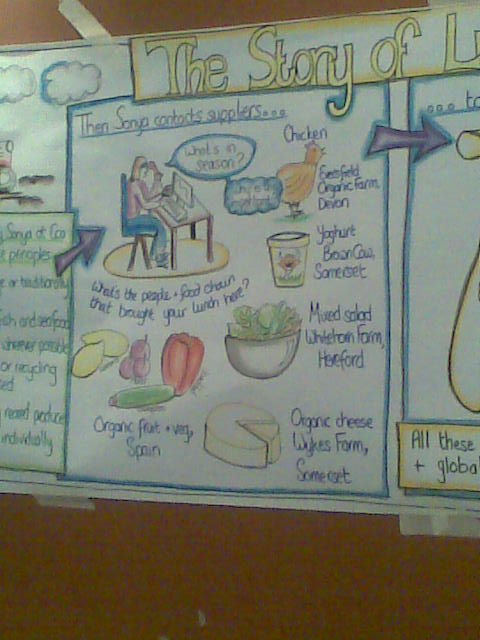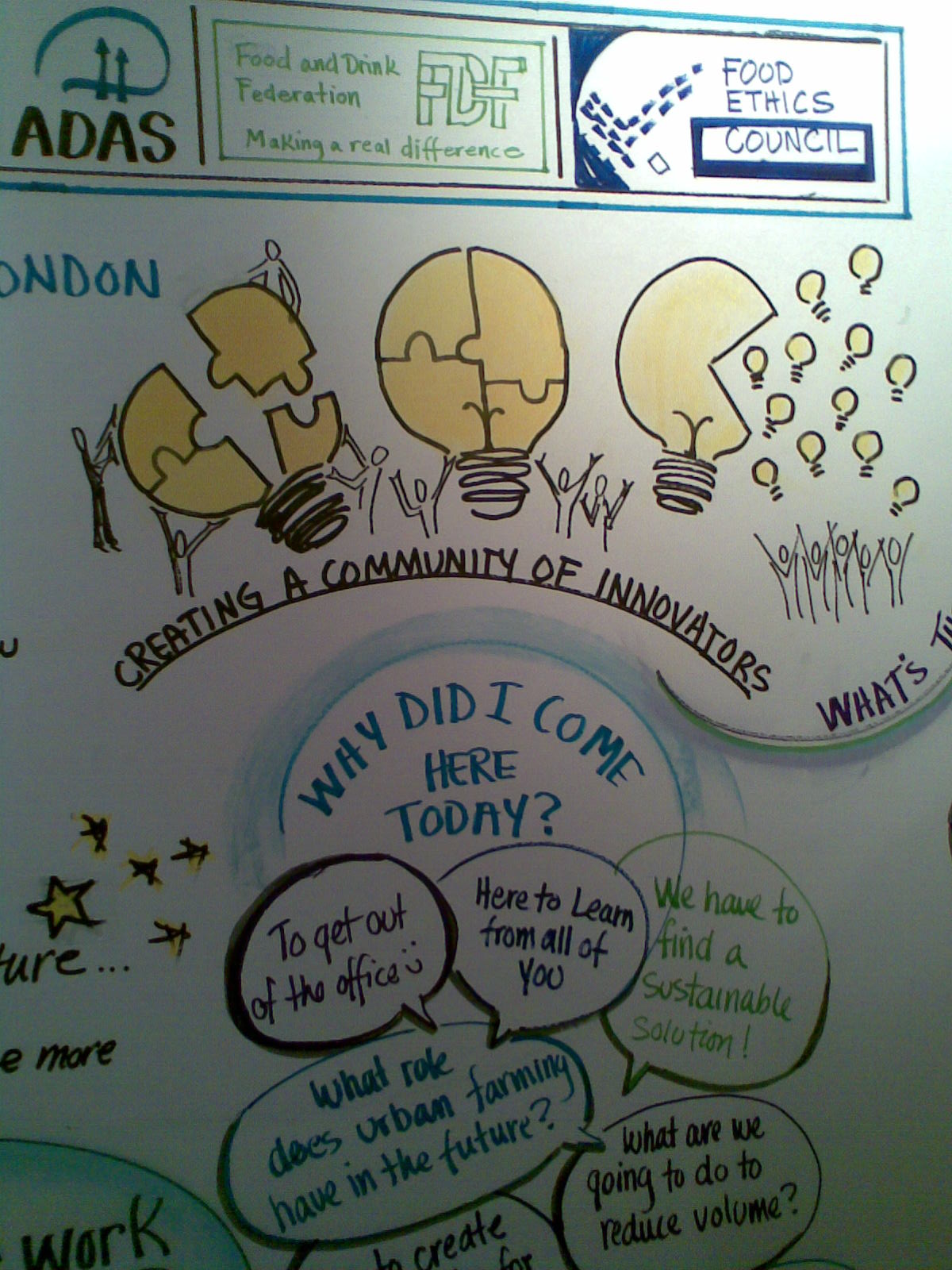As you may have noticed, I'm a process aficionado. I love to hear about innovative ways of helping people have the conversations they need. I love to try out new processes as a facilitator and a participant. I network with fellow facilitators through AMED, the IAF and a facilitators' group on linked-in. I read about unorthodox approaches, and sometimes I even try them with paying clients.
On Monday, I had the great treat of being a participant in someone else's workshop. There I saw for real - not in a training setting - open space, world cafe, graphic facilitation and live plenary mind mapping all used during the same meeting.
The event was the first 'assembly' for Tasting the Future, a collaborative whole-systems attempt to innovate the food system. It was organised by WWF, ADAS, the Food and Drink Federation and Food Ethics Council. Facilitation was provided by Hara Practice and Natural Innovation and other members of the hosting team. There were also some people doing graphic recording, from Intuitive Intelligence Training.
Some exciting conversations and actions emerged, and you can read more about them on the Tasting the Future ning. I'm going share some of the things I learned about process.
Dressing the room
When we arrived we sat where we liked at small tables covered with flip chart paper, with a small stack of coloured pens, crayons and chalk. There were small bowls of sweets and a colourful cartoon diagram introducing us to world cafe. And on each table there was a unique food or herb seedling, grown at Hackney City Farm, which you could buy to take home if you liked. Plants included apple mint, chamomile, lettuces, cabbage and tomato.
There was also this great picture story of our lunch: very appropriate for an event like this.
Setting the tone
There were a couple of phrases I scribbled down during the opening session. The hosting team asked us to be strong enough to work with our differences, to become a community of innovators, to speak with intention. We were invited to 'listen louder' if we disagreed with what someone was saying, so that we could better understand their perspective rather than blot it out with our own.
Meta-planning
Following couple of rounds of world cafe, we were asked to come up with our best ideas about what we wanted to change in the current system. We wrote these on A5 size stickies, and these were then meta-planned (clustered) in plenary. Bear in mind there were over 100 participants, and the facilitators among you will recognise the audacity of this. The hosting team had mikes and runners, and the lead facilitator began as usual by asking for any one idea. She then asked people with the same idea on their sticky note to shout 'snap!'. This was a great way of gathering up the clusters very rapidly. A supporter did the actual sticking up, while the facilitator asked for the next idea. It didn't take long for all the ideas to be gathered and clustered.
Whole group mind-mapping
Another daring bit of process for such a large group was the method used to identify topics for the subsequent open space session on action planning. We all gathered around a long wall, where a large blank area of paper was taped up.
The focus question was posed: "Where do we need to take action?". (Actually there was an adjective in there, but my memory and my photo have let me down. Could've been 'where do we need to take collective action' or 'urgent action'.) Then the facilitator asked us to write our name legibly on a sticky note if we had an idea we wanted to add to the mind map. Rules for the mind map included that there's no such thing as a bad idea, it's fine to disagree with a previous idea, and the owner of the idea gets to say where on the map it goes. There were support facilitators collecting up the names so the lead facilitator could call people by name. Other members of the team had mikes and ensured each person making a contribution could be heard. Two of the team were scribes, with four colours of marker pens. As a new theme and idea was added, the scribes would write it up on the evolving map.
One at a time, those who wanted to offered ideas for action, and said whether they were twigs to add to existing branches, or new branches. This went on for about 30 minutes. It was beautifully controlled, and everyone who wanted to had an opportunity to contribute.
When the mind map was complete, we were each given three dots and invited to use them to indicate which actions we thought were the most important. Over tea, the dots were counted and around a dozen action areas were identified which had enough support to be the topics for the subsequent open space action planning session.
Open space
Over tea the room was rearranged so there was one large circle in the middle. The topics which had emerged from the mind map were written up on large pieces of paper, each with a number which corresponded to a numbered part of the room. The method of sorting out who went to which session was simpler than I'd seen before. There was no signing up of participants to different topics, or assigning topics to time slots. Instead, there was one 50 minute time slot. Within that time, participants could go to whichever topic they wanted, and leave it whenever they wanted. This is the law of two feet. Topics were hosted by volunteer hosts, who put themselves forward while the open space was being organised. If a topic didn't have a host, it didn't run. There was also the opportunity for hosts to offer additional topics, and I think one was proposed at this stage.
Very soon we were ready to go to our spaces and discuss our topic. The host had a prepared flip where they were asked to record key information: topic title, who hosted, who participated, three key points to share and actions the group would take (if any). The guidance was very clear on actions: they were to be things someone in the group had agreed to take on, not recommendations for action by others. As the facilitator said "We're the ones we've been waiting for".
Graphic recording
As the day progressed, a team of graphic recorders captured the highlights in this lovely illustration.
Update
There have now been three Assemblies and other meetings and workshops as part of Tasting the Future. Check out the prospectus for more details.










